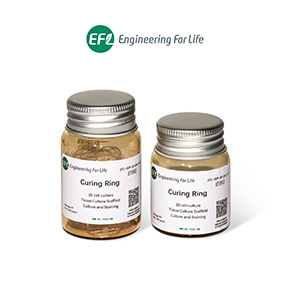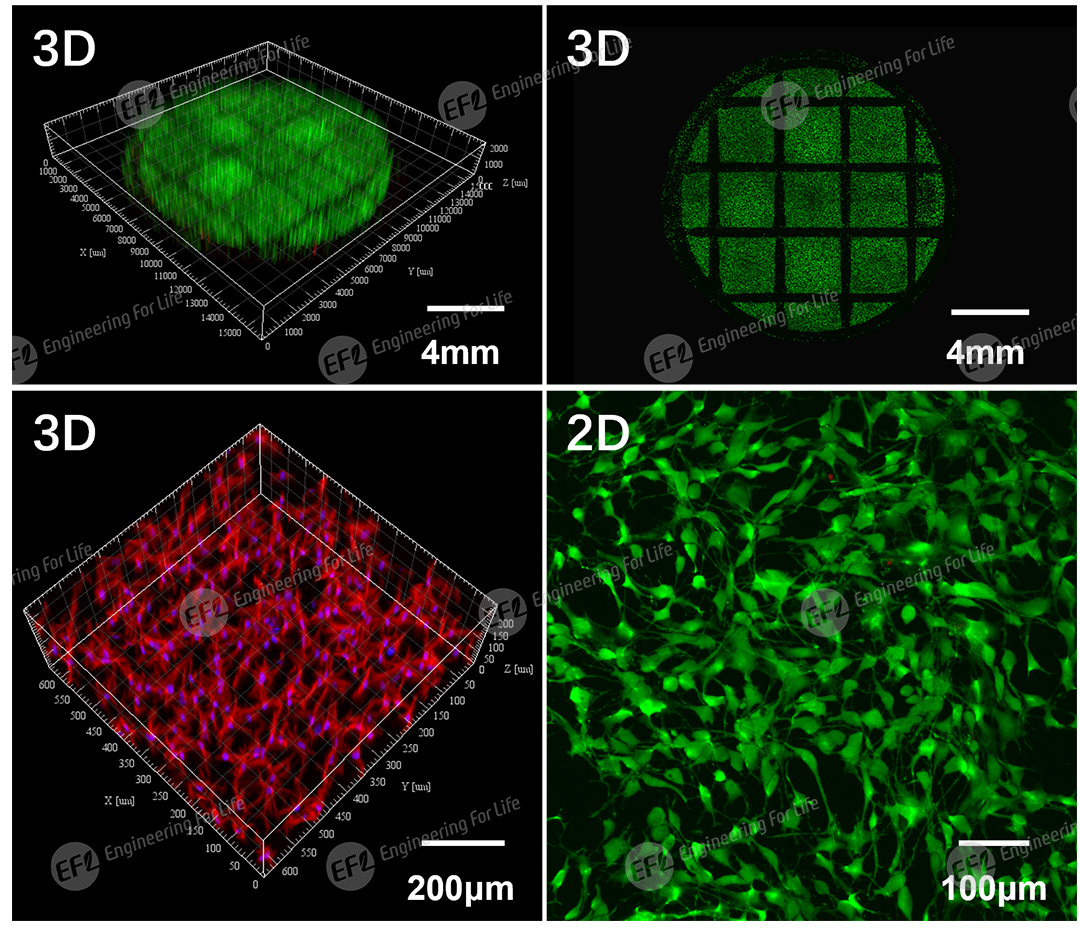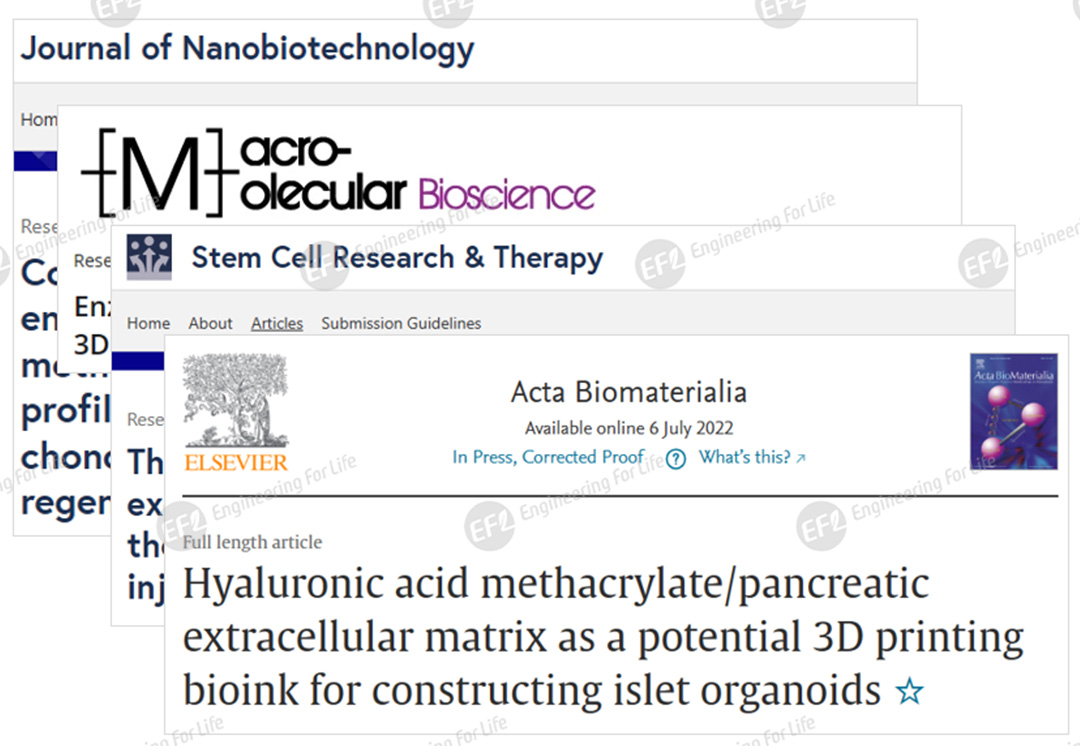Tel:0512-66958483
Email:engforlife-mkt@efl-tech.com


試劑/耗材
Reagents / Consumables

Curing Ring;
EFL-SCR Series
Salesperson:Panpan Wang(EFL)
Phone:15335258233
Email:engforlife-mkt@efl-tech.com
Foreign distributor:ANR Technologies Pte Ltd
Currently, hydrogels are primarily used for cell culture via in situ curing in well plates. Although this method is simple and easy to operate, it has the following limitations:
a. The hydrogel adheres tightly to the well plate, hindering substance and nutrient exchange between cells within the gel and the external environment. b. Pouring hydrogel into orifice plates can easily form a concave liquid surface, leading to intermediate agglomeration of surface cells. c. operational inconvenience during hydrogel removal from the well plate for characterization may cause the hydrogel to rupture. To address these drawbacks of traditional culture methods, after extensive practice and optimization, the EFL team developed the hydrogel cell culture auxiliary tool—Curing Ring (EFL-SCR Series). This product facilitates medium replacement, simplifies characterization, enables aseptic operations, and standardizes sample preparation.
Since its launch, the EFL-SCR Series has been widely praised by users. EFL has incorporated user feedback and optimized the product, now offering an upgraded version with enhanced durability and "multi-functionality in one ring":
?Function 1: Supports culture and characterization of cells on 2D hydrogel surfaces
?Function 2: Supports 3D intra-hydrogel cell culture and characterization
?Function 3: Supports culture of cell-loaded 3D-printed hydrogel scaffolds
By combining with EFL’s UV-curable hydrogels, controllable light sources, and hydrogel lysis reagents, users can perform 2D/3D cell culture experiments. This enhances nutrient penetration within hydrogels and improves cell viability. The product’s user-friendly design facilitates observation during culture, as well as subsequent biological staining, imaging, and other characterizations, ensuring convenience, quantifiability, and controllability in cell culture.

1. Smooth and flat surface minimizes cell agglomeration;
2. Suspension culture of gel blocks promotes substance and nutrient transport within the gel during 3D culture;
3. Rational structural design prevents hydrogel protrusion caused by swelling;
4. Simple liquid exchange clamping prevents gel blocks from being dislodged during medium changes;
5. Grid-assisted positioning aids observation;
6. Facilitates staining characterization without damaging gel blocks.
1. Compatible with EFL-LS-1601 portable light source for batch preparation of consistent-parameter samples;
2. Combined with GelMA lysis buffer and low-adhesion culture plates, enables high-quality cell extraction for subculture, protein, and nucleic acid analysis, improving purity;
3. Paired with a biological 3D printer, suspends cell-loaded scaffolds in culture medium to enhance intra-scaffold substance/nutrient transport and promote uniform cell growth;
4. Versatile design compatible with other curing and molding methods.
2D cell culture, 3D cell culture, cell hydrogel scaffold culture, etc.
This product is sterilized by gamma ray irradiation, valid for 2 years, the production date is on the outer package.
Taking mouse osteogenic precursor cells (MC3T3-E1) cultured on/in GelMA hydrogels as an example, the effects of Curing Ring-assisted cell culture characterization are demonstrated.

Fig 1. The cytoskeleton staining kit that can be used is: TRITC-Phalloidin (Rhodamin-labeled penicyclin EFL-FA-001). The cell viability staining kit that can be used is: EFL- LCD-001
1. Combined with portable light source (EFL-LS-1601): batch preparation of consistent-parameter samples;
2. Combined with GelMA lysis buffer (EFL-GM-LS-001) and low-adhesion cell culture plates (EFL-TCP-0024), enables high-quality cell extraction for subculture, protein, and nucleic acid analysis, improving purity;
3. Biological 3D printer: Suspends cell-loaded scaffolds in medium to enhance intra-scaffold transport and uniform cell growth;
1. The anti-sticking film can be reused after being wiped with 75% alcohol and air-dried.
2. Curing Ring is not resistant to high temperatures. Do not sterilize it at high temperatures.
3. During curing, adjust laminar flow hood air velocity to prevent material drying.
4. For non-GelMA hydrogels, follow their specific gelation protocols.
5. When the GelMA lysis buffer (EFL-GM-LS-001) covers Curing Ring and is cultured at 37℃, the GelMA gel blocks on Curing Ring can be rapidly lysed and the cells released within about 0.5 hours.
6. It is recommended to use the portable 405nm curing light source (EFL-LS-1601), which has stable light intensity, adjustable curing time and more stable sample preparation.
Demonstrated using GelMA as an example: protocols for Curing Ring-assisted 2D hydrogel surface cell culture, 3D intra-hydrogel cell culture, and cell-loaded 3D-printed hydrogel scaffold culture.
Video 1: Curing Ring-assisted hydrogel for 2D/3D cell culture
Video 2. Culture of cell scaffolds in Curing Ring
DOI:10.1016/j.actbio.2022.06.036
DOI:10.1186/s12951-022-01352-6
DOI:10.1002/mabi.202100189
DOI:10.1186/s13287-020-01719-2

【Product Manual】-【EFL-SCR serices】-Cruing Ring